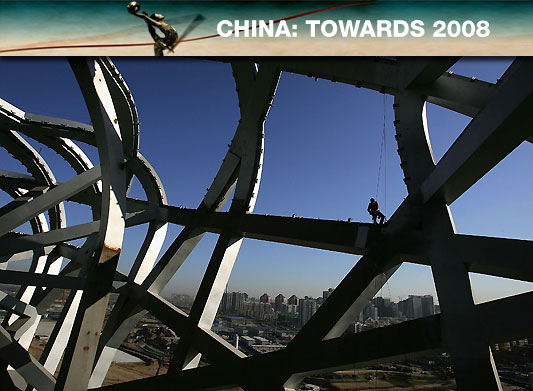Beijing’s Olympic new look
Beijing’s Olympic architecture is striking, but is it Chinese enough?

 |
| The giant Bird’s Nest Olympic stadium is the centrepiece for the 2008 games [GALLO/GETTY] |
Reaching up high into the sky, it’s a twisted mass of steel and cables with huge holes and random shapes which become translucent as the sunlight runs through it.
Enormous lumps of metal, wrenched and bent in all sorts of unnatural poses, intertwining to form a bizarre web, as workers precariously balance on top, like ants dwarfed by this superstructure.
But it’s only when you walk back a little that the shape starts to come together, revealing why they call Beijing’s 100,000-seat Olympic stadium “the Bird’s Nest”.
| Special coverage | ||||||
|
|
As the summer sun bathes the stadium in light, the sharp edges of the twisted girders come together to form a smooth dipping surface at each end.
And the radical design doesn’t stop there.
The aquatic centre next door is covered in an equally awe-inspiring coat, a fully breathing membrane that dissipates light and, the designers say, will naturally regulates the temperature inside.
Blue cushions of irregular shape sit in a steel frame, creating the impression that the building has been inflated.
The Olympic site is certainly shaping up, and there is little doubt that it will be completed well ahead of time, unlike its predecessor in Athens.
We even managed to get a glimpse inside the stadium, which is officially off limits until the opening ceremony.
 |
| The completed stadium promises to be a striking sight [Herzog & de Meuron] |
There’s still a lot of work to do inside, but already the basic seating is in place and you can see the incredible shadows cast across what will be the main track area by the shape of the outer shell.
The award winning Swiss architects, Herzog and de Meuron, have created a unique stadium that is likely to leave quite an impression on the ancient Chinese capital.
But while the name “the Bird’s Nest” conjures up images of China, critics say the stadium doesn’t.
There’s no trace of Chinese culture in the design, and shouldn’t such a prestigious job have gone to a Chinese architect?
It’s a messy jumble of expensive materials, they say, that serves style and has little substance. It’s an architectural experiment gone wrong.
“The architect should be ashamed”, Professor Alfred Peng of Beijing’s Tsing Hua University told me.
 |
| Critics have said the new buildings are out of keeping with the rest of Beijing [EPA] |
“I don’t think he could build this in his own country, or any other western country – why China?”
Professor Peng is not alone.
An increasing number of Beijing residents are worrying about their city becoming a testing ground for radical architecture.
Striking new buildings like the opera house and the headquarters of CCTV, the state broadcaster, have drawn much criticism.
And even if you enjoy the cutting edge design, it’s hard to dispute that the vast majority of Beijing’s new buildings are faceless and forgettable skyscrapers, built at the cost of the cities old courtyard homes.
But whatever you think about the Bird’s Nest, it certainly stays in the mind – and that’s perhaps an appropriate symbol for the most keenly anticipated Olympic games of modern times.
